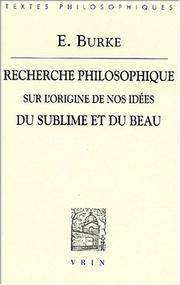| Listing 1 - 4 of 4 |
Sort by
|
Book
Publisher: Paris Centre de Création Industrielle (Centre national d'art et de culture Georges Pompidou) en Editions de Minuit
Abstract | Keywords | Export | Availability | Bookmark
 Loading...
Loading...Choose an application
- Reference Manager
- EndNote
- RefWorks (Direct export to RefWorks)

ISBN: 2711600971 9782711600977 Year: 1990 Publisher: Vrin
Abstract | Keywords | Export | Availability | Bookmark
 Loading...
Loading...Choose an application
- Reference Manager
- EndNote
- RefWorks (Direct export to RefWorks)
Aesthetics --- Sublime, The --- Esthétique --- Sublime --- Early works to 1800 --- Ouvrages avant 1800 --- Esthétique --- Esthétique - Ouvrages avant 1800
Book
Year: 1973 Publisher: Paris Vrin
Abstract | Keywords | Export | Availability | Bookmark
 Loading...
Loading...Choose an application
- Reference Manager
- EndNote
- RefWorks (Direct export to RefWorks)
Dissertation

Year: 2007 Publisher: Leuven K.U.Leuven. Hoger Instituut voor Wijsbegeerte
Abstract | Keywords | Export | Availability | Bookmark
 Loading...
Loading...Choose an application
- Reference Manager
- EndNote
- RefWorks (Direct export to RefWorks)
The discussion of the nature of beauty in the eighteenth-century is set within the philosophy of a standard of taste. Part I of the work, 'Beauty and the Standard of Taste', concerns theories of taste between the years 1708-1759. In chapter 1, six key eighteenth-century writers on the subject of taste are introduced: Shaftesbury, Addison, Du Bos, Hutcheson, Hume and Burke. After describing a growing commitment to the philosophical justification of taste-in which pleasure and universality are argued to co-exist in taste-chapter 2 defends Burke's definition of beauty in its formal, material and efficient causality. The central aspect of beauty is thus its formal cause, the passion of love. In chapter 3, it is seen how Hume and Burke differ in their particular contexts. Within a view of 'naturalism', the three requirements forming the basis of the Burkean theory of beauty (i.e. pleasure, passion and delicacy of imagination) constitute a stronger and more appealing justification for the standard of taste than that of Hume's ideal critic. An excursus to part I shows further how 'Burkean taste' is relevant to contemporary aesthetics (specifically with regard to Sibley, Scruton, Levinson and Robinson). Part II of the dissertation concerns the advent of the sublime. Locke and Burke's anthropology are the impetus for chapter 4, in which two aspects are highlighted: pleasure/ pain and personal identity. With the help of a short story by Edgar Allen Poe, this chapter argues that Burke disagrees with Locke's qualifying pain as evil, but situates pain instead as a constitutive element for personal identity. In chapter 5, the nature of the sublime and its formal relation to fear mirrors the analysis of beauty performed in chapter 2 and further demonstrates Burke's Aristotelian understanding of the functionality of the sublime (in its formal, material and efficient causes). In the second half of chapter 5, the nature of the sublime is introduced through Immanuel Kant's oeuvre. Compared to his Observations on the Feeling of the Beautiful and the Sublime (1764) and Anthropology from a Pragmatic Point of View (1798), it is claimed that Kant moves from a more empirical account to a 'transcendental account' in his Critique of the Power of Judgment (1790). The specifically religious power of the sublime is described in chapter 6 in light of the influence of John Milton's Paradise Lost on Burke. This power is interpreted such that the 'fear of death' in Burke's Milton cannot be understood without having a religious imagination. Following a reading of Kant on the power of the sublime in the third Critique, the fear of death is then described in Spinoza, one figure who may be argued as refuting the positive power of passion. Lastly, an epilogue to the work discusses how Burke and Kant have been read by other twentieth-century Anglo-Saxon and French writers (i.e. Guyer, Makkreel, Zammito, Allison, Derrida, Lyotard and Saint Girons) on the subject of the sublime. One might see in these authors a growing progression towards an emphasis on the Burkean sublime in contemporary aesthetics. This dissertation is the first sustained philosophical and contextual reading of the Anglo-Irish politician Edmund Burke's (1730-1797) text, A Philosophical Enquiry into the Origin of Our Ideas of the Sublime and Beautiful, published 250 years ago in 1757 (a revised 2nd ed. appeared in 1759). By focusing on the philosophical, historical, literary and religious contexts in particular, beauty and the sublime are read outside of Burke's political career and within the context of the birth of aesthetics in the long eighteenth-century. This birth is seen as influenced by the growing concern with taste and passion in British philosophy over against reason and abstraction. A simplification of the outline of this dissertation can also be seen in the following diagram: Part I: Beauty Chapter 1: Pleasure Chapter 2: Passion-love Chapter 3: Delicacy Part II: the Sublime Chapter 4: Pain Chapter 5: Passion-fear Chapter 6: Power Each of these chapters attempts to articulate one of the key constitutive elements of understanding beauty and the sublime in their historical context. The vulnerability of the human being to these elements is thus necessary to move beyond an 'abstract' philosophical discussion of aesthetics. The dissertation concludes with a statement concerning the future of aesthetics as existing between the two affective spheres of beauty and the sublime without reducing one to the other.
| Listing 1 - 4 of 4 |
Sort by
|

 Search
Search Feedback
Feedback About
About Help
Help News
News